The LoneStar Sport Helicopter
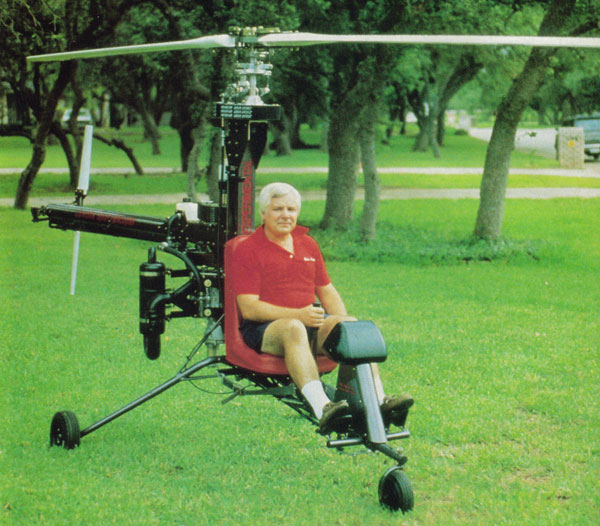
The LoneStar Helicopters clean and simple design will appeal to many. A minimalistic and compact helicopter that’s easy to store and maintain.
The all – new LoneStar Sport Helicopter by Star Aviation, Inc. is the brainchild of Tom Carlson and Ken Rehler, both of San Antonia, Texas. Building of the prototype helicopter began just six months ago. Since this has been a full- time project, it hasn’t taken the years of building most of us homebuilders have experienced previously, going from idea to completed flying project. However, just like all homebuilt aircraft projects, after 99 percent of the bird is completed, the last one percent takes nearly as long as it did to get to the 99 percent point.
I received information on this chopper shortly after its conception. The “pictures” I got were really hand sketches, and it looked a lot like typical “pie-in-the-sky” dreaming rotorcraft. However, that dream has finally become a reality. I first saw the LoneStar helicopter at the PRA International Rotorcraft Fly-In at Hearne, Texas this summer. It was the most beautiful machine there and probably drew the most interest. The most disheartening part, in my opinion, had to be the fact that at the PRA, the LoneStar kit helicopter only took Third Place in the helicopter awards, behind, of all things, a factory-built, totally stock Robinson R-22! A real nice Scorpion 133 deservedly took First Place – well, at least that was a homebuilt! (Okay, I’ll admit, I’m prejudiced toward homebuilts.)
Helicopter Magazine Quotes:
The LoneStar Sport helicopter can truely be called one of the best values in sport aviation today, with a kit price well below most other experimental helicopters currently available.
Ken and Tom had tried desperately to get the LoneStar helicopter flying in time for the Fly-In but, even though they were working day and night, they still ran out of time before they could, and didn’t get the control linkages done. So, needless to say, it still hadn’t been flown, and that really disappointed a lot of would-be customers. Now, however, the bird is finally finished, and a phone call to Ken a few minutes ago confirmed that the LoneStar helicopter is going to fly this coming weekend.
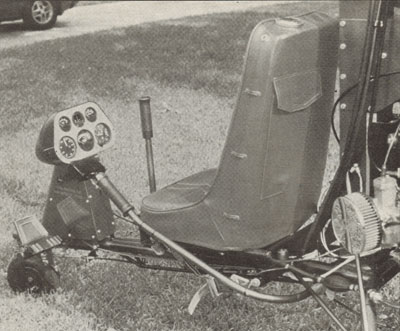
LoneStar Experimental Kit Helicopter (Ver.1) “cockpit”. In this picture you see the anti-torque pedals with cyclic and collective controls along with the “seat-tank” fuel supply. All are mounted on a chromoly frame.
So, by the time you read this, we should have a new, exciting, revolutionary helicopter streaking through the skies. At which time we hope to do a follow-up article taking you through its flight parameters.
The kit for the LoneStar, a single-place sport helicopter, is easy to assemble and can be built in a few weeks using common hand tools. No welding is required. This lets you get into the air more quickly! The instruction manual will clearly show you with illustrations exactly how to assemble the kit and make the adjustments necessary for smooth operation.
The nice part about the LoneStar helicopter is that it is relatively inexpensive to purchase, fly and maintain. As with most rotorwing aircraft, it is easily transportable, and you don’t have to worry about monthly hanger fees because it can be stored in a one-car garage. And, since it has wheels instead of skids, ground handling is a breeze. With its specially designed trailer, all loading and unloading is a simple, one-person job. Also, since it uses automobile gasoline, the cost of operation is reduced dramatically.
But more than just economical, this craft combines good looks with state-of-the-art components and a high level of performance. Further, it’s developers are constantly improving their design, and these enhancements can typically be retrofit by the builder well into the future. The LoneStar has garnered Best-Of-Show awards and critical praise from both sport aviation magazines, helicopter pilots and owners. As of writing, the craft has a perfect safety record.
The LoneStar helicopter was designed for a pilot weighing 130 to 225 pounds. However, it can carry either a heavier, or lighter pilot if a balance weight is placed near the tail rotor or the nose gear. The maximum weight with which the helicopter can hover out of ground effect is 650 pounds. This means that on top of the 370 pounds which the aircraft weighs, you can add a 170-pound pilot, 55 pounds of fuel (8.9 gallons), and 55 additional pounds of whatever else you desire (maybe video surveillance camera equipment, communications equipment or air rescue first-aid supplies).
All hardware is cadmium-plated, and all aluminium parts are anodized. All controls are carried on sealed, lifetime-lubricated bearings. The fuselage is made from 4-inch-square aluminium. The landing gear is a tripod-type with fixed wheels on the main gear and a castering nose wheel. This design provides for ease of maintenance and reduced cost and building time.
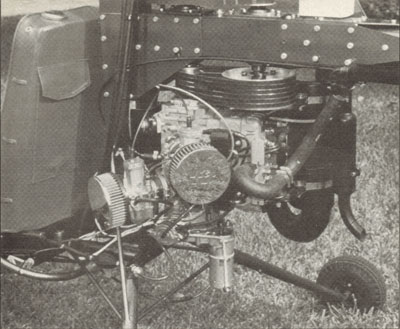
Helicopter Engine With Manual Clutchable V-belt Primary Power Transmission
The pilot’s seat serves as the 8.9 gallon fuel tank which gives you a range of 115 miles at a cruise speed of 65 miles per hour while burning 5 gallons of fuel per hour. It has a projected top speed of 90 miles per hour which would of course, burn more fuel and reduce your flight range.
Power is supplied to the rotor blades by a Rotax 582, two-cycle, two-cylinder, liquid-cooled, vertically mounted engine. It has oil injection and factory-set dual CDI units which require no adjustment by the user. The engine is completely vibration isolated from both the frame and the drive system improving comfort.
Considerable research was done by the LoneStar helicopter designers to provide a drive system which was not only quiet and efficient, but would also allow the owner/pilot to easily verify its condition before flight. Because of these design goals, a multi-stage v-belt reduction was chosen for its simple, efficient and reliable operation. All drive shafts ride on sealed, lifetime-lubricated ball bearings. The standard helicopter autorotation overrun clutch is mounted on the primary engine reduction unit. The clutch has no external controls and disengages automatically during autorotation and engine shut down.
Some of the outstanding features of the LoneStar are it’s infinite-life, composite rotor blades; a relatively short tail boom to maximise safety and for ease of storage; an elastomeric rotor head system for smoother performance; a choice of engines to best suit ones budget and flight circumstances; and an overall ease and simplicity of construction to enable the builder to get into the air in the shortest possible time.
The tail rotor is driven from the secondary drive shaft above the overrun clutch by a one-piece, maintenance-free cog belt. The helicopter rotorblades are manufactured by McCutchen Sky Wheels, Inc. using composite technology construction which provides unequalled strength and durability. These composite blades are not subject to the same fatigue factor as all metal blades and are very resistant to weather.
One of the really neat things I liked about the Lonestar Kit Helicopter is the fact that the tail (and tail rotor) does not extend behind the main rotor. This means that any place you can get your whirling rotorblades into, the tail (and tail rotor assembly) will also fit without having to worry about bumping the tail on an object as most helicopters are prone to do.
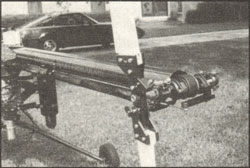
Gates Polychain Cogbelt Driven Tail Rotor Twisted 90 Degrees
The bird has a 12-volt electrical system which makes it handy to add on those gadgets which we pilots just can’t fly without navigation aids, communications equipment (12-volt electric shaver, coffee warmer, etc.).
It also sports all standard helicopter controls so you don’t have to learn any new twists in order to fly it. This makes it real easy to get your training in a standard category helicopter, without any negative-transition-learning-curve when you climb aboard your LoneStar kit helicopter.
As options, you can add an instrument pod which includes the basics such as an engine tachometer, compass, water temperature gauge, ASI (Air Speed Indicator), rotor tachometer, Hobbs meter and altimeter.
The LoneStar kit, minus engine and instruments, is available for under $15,000USD. Affordable engine/instrument packages are available as well. (EDITORS NOTE: No longer available).
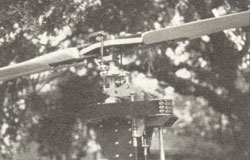
Cog Belt Reduction Drive To Helicopter Rotorhead – another current kit helicopter uses this exact idea!
With a sales price of $17,500, guaranteed delivery time of less than 120 days, the ease of assembly (weeks instead of the years it often takes for homebuilts), I predict that Tom and Ken have a real winner on their hands.
In fact, Ken tells me that orders for the kits received so far, (both from the US and other countries) are more than three times what they had projected.
It looks like there’s a niche in the marketplace for an inexpensive, one-man helicopter. (A two-person version, dubbed the “TwinStar” may debut within another year.)
Helicopter News

HOMEBUILT ROTORCRAFT MARCH 1992
FAA EVALUATES LONESTAR KIT HELICOPTER
The Federal Aviation Administration (FAA) has completed evaluation of the LoneStar Sport Helicopter kit, a single seat helicopter being sold by Star Aviation, Inc. in New Braunfels, Texas. After a review of each part in the kit, the manual and parts list, they determined that the kit meets the intent of the Federal Aviation Regulation (FAR) 21.191 (g), Operating Amateur-Built Aircraft. This regulation states that the major portion of the completed aircraft may be fabricated and assembled by persons who will undertake the construction project solely for their education and recreation.
The LoneStar Sport Helicopter kit was found to be eligible for airworthiness certification under FAR 21.191 (g). The LoneStar will appear in the next revision of the Listing of Eligible Amateur-Built Kits. All FAA field offices have been notified by electronic mail of the results by their Manufacturing Inspection Office.
Star Aviation, Inc. is a relatively new company, beginning operation in March 1990. They produce only the LoneStar Sport Helicopter which is being shipped worldwide to individuals desiring to own and fly their own “personal helicopter”. Shipments of the kits started early last year (1991). The kit cost is $18,500 and takes about 160 hours to build. (See editors note at bottom of page)
PLEASE NOTE: Star Aviation is no longer in existence and the LoneStar kit helicopters are no longer produced. Mr Ken Rehler passed away recently so this is the only known remaining source of information licenced to be advertised and distributed to the public. All property is copyright protected.






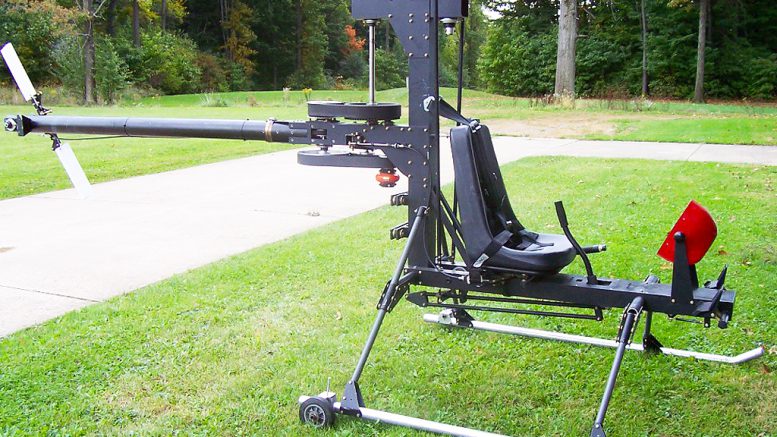
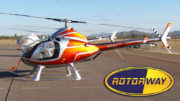
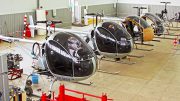
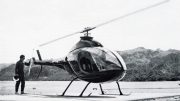
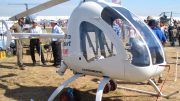
Dear Sr.
I visit your web site and I interested in your product
Please could you quote me the following ref.
Lone star kit helicopter without engine.
Best price
Best regards.
Javier Echavarria
Hi Javier, we do not sell any helicopters or kits, we just provide information for homebuilt helicopter builders. Thanks, Adam
I am interested in the Loan Star if it looks like the sport version. I think it will be a great performer can you tell me if there is an option to build yourself or kit only.
Mick.
Australia.
Hi Mick, there are no complete plans for the LoneStar kit helicopter any more. We sell “partial plans” only for the last version made. They are incomplete, but show many of the parts needed. I have recently heard of a disassembled LoneStar for sale in Queensland’s inner Sunshine Coast region, it is same as the model seen flying on my YouTube channel. It is fairly complete (less engine) – but has all major components. Last I heard, asking was around $25 – 30,000 AUD – if still available.
Unfortunately the owner had an accident in his construction business and now suffers many incapacities so is unable to make use of it or assist with moving it.
Hi I am the the man mentioned in the above comment and I am looking to sell. It’s a lone star sport 99% complete (missing a few none critical brackets) comes with a 582 Rotax engine. The airframe has zero hours the engine hours are currently unknown.
EDITOR: For anyone interested in buying this helicopter, I can personally verify Ross as a genuine seller and reliable to deal with.
Aloha from Hawaii,
Could you please provide some informations, a design plan on how I can build a homebuilt helicopter like the Lone star helicopter you have in the picture. Please let me know if you sell parts needed to build one of this. I thank you in advance for your help.
Mahalo
Ed Acuna (808)277-9613
You can try:
https://www.vortechonline.com/specials/
http://www.redbackaviation.com/category/helicopter-shop/helicopter-plans/
Hello, I happen to have a Lonestar Helicopter, built by a retire airline pilot. Complete with all plans and books. I would be interested in selling. It’s actually the blue one you see online from time to time in front of the windrow. THX Brian